Like stepping into a Western film, you can leave Tucson’s city hum for saguaro-studded roads, cool pine ridges and underground caverns in a single day. You’ll find easy drives, short hikes and quick cultural stops that fit a relaxed schedule, whether you want desert panoramas, mountain air, stargazing or old-town history. Keep going to pick the trip that matches your pace and the views you want to wake up to.
Saguaro National Park East: Rincon Mountain Loop
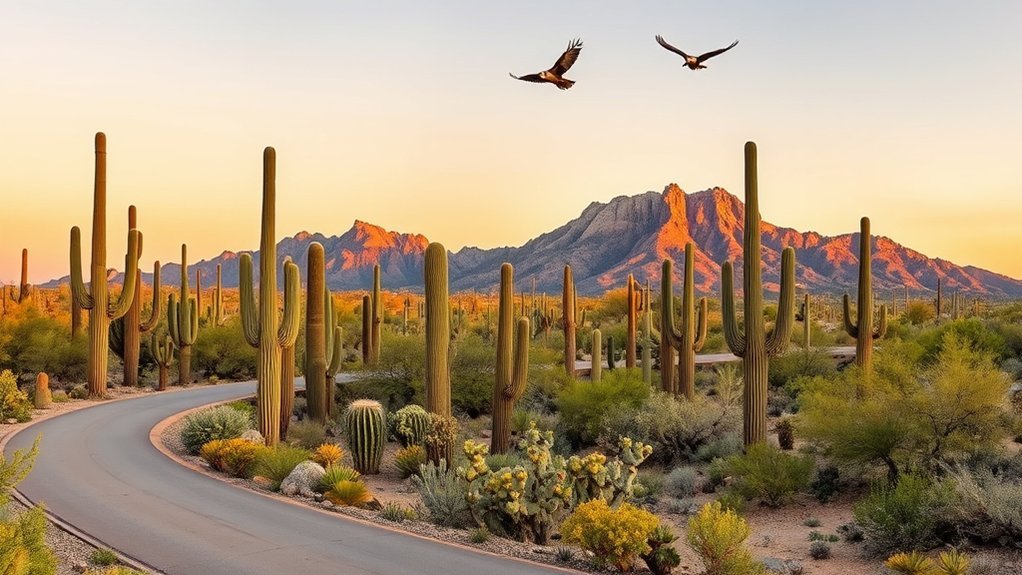
Stretching east of Tucson, the Rincon Mountain Loop in Saguaro National Park East invites you into a quiet world of towering saguaros, rocky ridgelines, and wide Sonoran skies. You’ll follow a mix of paved road and dirt spur that curves through cactus forests, dropping you at trailheads where shade is rare and views are big. Early mornings reward you with cool air and long shadows that sculpt the landscape; afternoons bring shimmering heat and golden light on granite. You’ll notice birds flitting among the arms of saguaros, hawks circling ridgelines, and occasional javelina tracks in wash bottoms. Pack water, sun protection, and a map — cell service can be patchy. Short hikes off the loop reveal historic ranch ruins and flowering ocotillo in season. The loop’s rhythm is unhurried: you’ll slow down, look closely, and come away with a quiet sense of desert order and scale that feels both ancient and immediate.
Mount Lemmon Scenic Drive and SkyRide
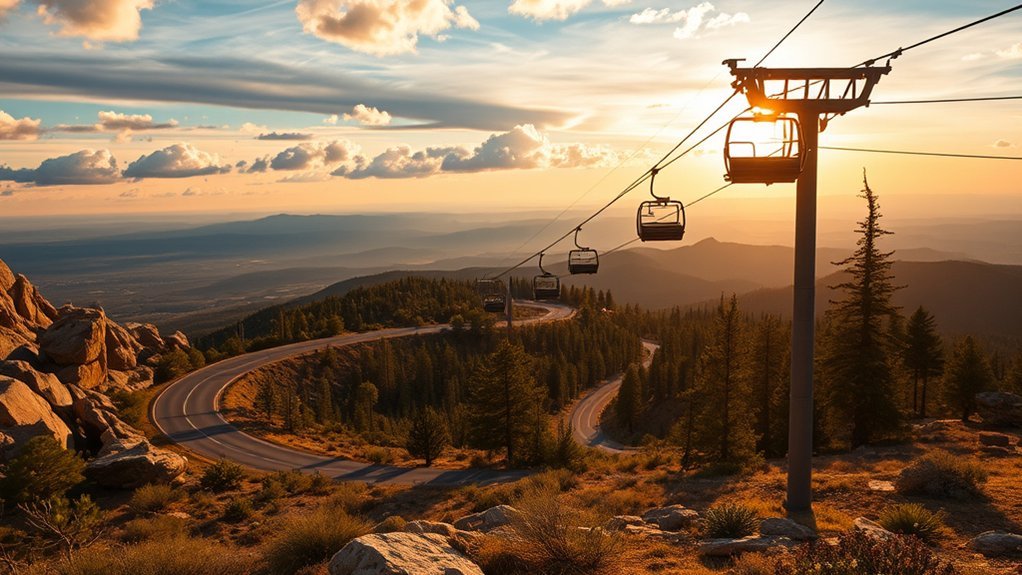
You’ll wind up from the desert into cool pine forests on the Mount Lemmon Scenic Drive, with switchbacks that open panoramic views of Tucson and the Catalina foothills. Take the SkyRide for a bird’s-eye perspective—bring a jacket, camera, and an eye for changing light as elevation and weather shift quickly. Plan for slower traffic on weekends and check ride operation times so you don’t miss the last trip down.
Scenic Drive Highlights
When you climb the Mount Lemmon Scenic Drive, the desert peels away and a cooler, forested world opens up—pinyon and ponderosa replace saguaros as switchbacks reveal sweeping views of Tucson and the Rincon Mountains. You’ll notice how light shifts: hard, bright desert sun softens beneath needles, shadows lengthen across rocky outcrops, and distant ridgelines recede into blue. Pull over at turnout points to scan for javelina or hawks, and watch tiny wildflowers cling to crevices. The pavement curves through varied habitats, each mile offering new perspectives — granite chimneys, aspen pockets, sudden meadows. Your camera will want to keep working. Drive slowly, breathe the cooler air, and let the changing landscape remind you how quickly elevation can transform a region.
SkyRide Experience Tips
After soaking in the switchbacks and alpine pockets along the Mount Lemmon Scenic Drive, plan for the SkyRide to lift you even higher—literally and visually—into cooler air and panoramic views that stretching car windows can’t match. You’ll step into a gently swaying gondola, watch saguaros shrink, and feel a quiet hush as the city drops away. Bring layers—temperatures can change fast—and a camera with a steady grip for sweeping desert-to-forest shifts. Move slowly, breathe, and let your eyes track ridgelines and distant peaks.
- Buy tickets in advance and aim for mid-morning light to avoid crowds.
- Sit on the uphill side for unobstructed vistas and sunlit canyons.
- Secure loose items and use a wrist strap for small cameras.
Sabino Canyon: Tram Rides and Hiking
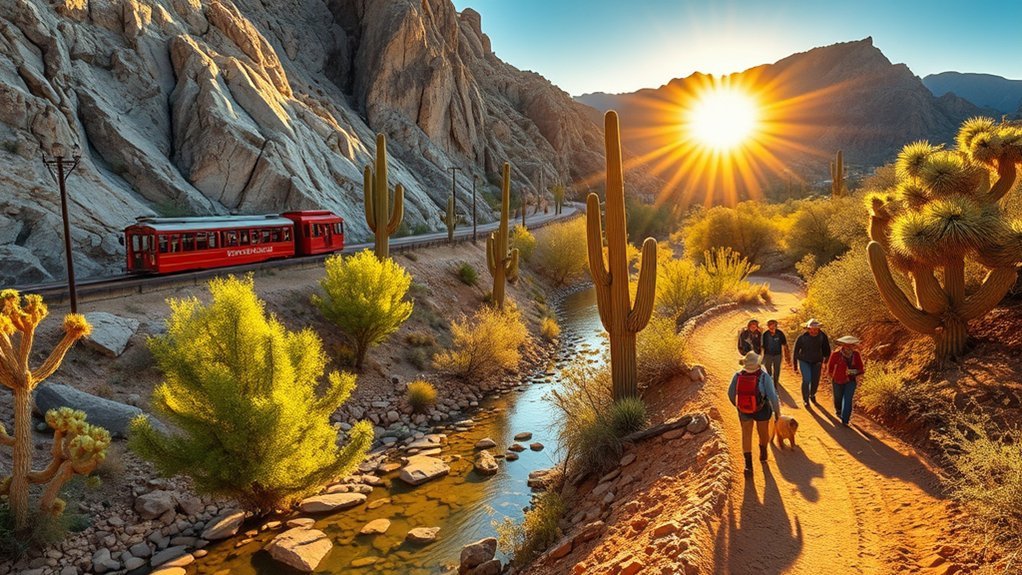
Nestled against the Santa Catalina Mountains, Sabino Canyon offers a quick escape into Sonoran Desert scenery where you can hop a narrated tram for an easy, scenic loop or strike out on well-marked trails to discover waterfalls, saguaros, and sweeping canyon views. You’ll climb aboard the tram to relax and learn about geology, wildlife, and local history as the driver points out photo-worthy overlooks. If you prefer moving at your own pace, choose from gentle washes and steeper ridgelines that reward you with quiet pools after rains and broad panoramas of Tucson below. Bring layered clothing, sun protection, and plenty of water—temperatures swing and shade is limited. Keep an eye out for javelina, roadrunners, and occasional hawks. Trails vary from stroller-friendly paths to challenging switchbacks, so pick a route that matches your energy and schedule. Whether you’re after a leisurely ride or a brisk hike, Sabino feels like an immediate, invigorating desert retreat.
Kartchner Caverns State Park: Underground Wonders
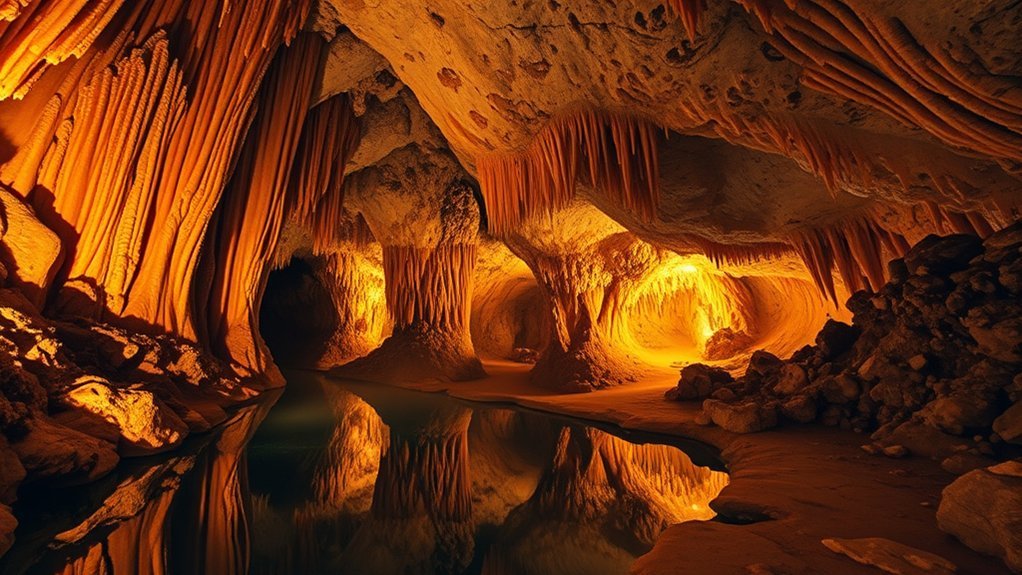
A cool hush greets you as you step into Kartchner Caverns State Park, where limestone formations have been sculpted over millennia into glittering columns, delicate soda straws, and vast flowstone curtains. You follow a guided path that keeps the cave’s fragile beauty intact, noticing how light and shadow reveal textures like an underground cathedral. Your guide points out mineral hues and growth patterns, and you hear the soft drip that marks geological time.
- Walk the curated trails and watch speleothems glow under subtle lighting.
- Learn about cave conservation and the careful work that preserves these chambers.
- Feel the steady, cool air and count the quiet drips that shape the cave.
Aboveground, the park offers peaceful desert views, but underground is the true marvel. You’ll leave with a deeper sense of patience and perspective, impressed by slow processes that create such immediate wonder.
Tombstone: Historic Wild West Town
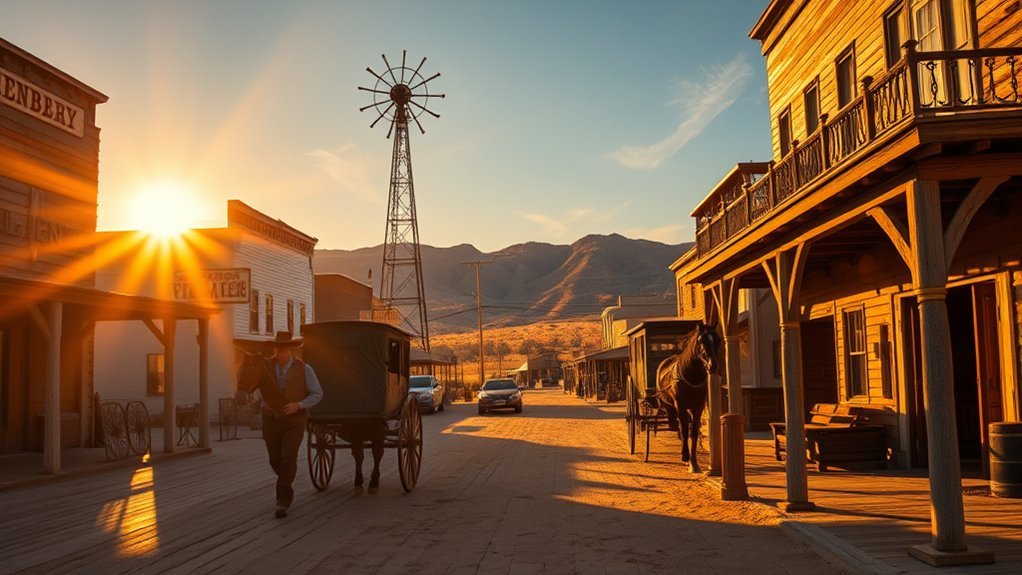
You’ll feel transported as you stroll down Tombstone’s weathered Main Street, where wooden storefronts and period signs pin you to the 1880s. Keep your eyes peeled for costumed characters and living-history exhibits that bring the town’s rough-and-tumble past to life. Then catch a live gunfight reenactment in the square — it’s loud, theatrical, and exactly the kind of Wild West spectacle you came for.
Historic Main Street Sights
Step back into the era of six-shooters and saloons as Tombstone’s wooden sidewalks and ornate storefronts put the Old West on full display. You wander past faded signs and cast-iron facades, feeling the dusted sunlight and hearing distant horse hooves in your imagination. Each building holds a story; you read plaques, poke into antique shops, and catch glimpses of period clothing in window reflections. Don’t miss these standout sights:
- Crystal-clear detail at the Bird Cage Theatre: velvet, tin ceilings, shadowed balconies.
- The Al K. Horton Museum: polished artifacts and miner tools that map daily life.
- Historic O.K. Corral area: preserved structures and plaques that anchor the town’s lore.
You’ll leave with photos, questions, and a vivid sense of place.
Tombstone Gunfight Reenactments
Often, performers recreate the famous Tombstone gunfight with uncanny attention to detail, drawing crowds onto wooden sidewalks as mock gunfire cracks and period costumes swirl. You step into scenes where actors channel hardened lawmen and defiant outlaws, their voices sharp, movements choreographed to look spontaneous. You can feel the dust settle as horses shift and spectators lean forward, phones tucked away for a moment so the past can dominate. Guides add context between scenes, explaining motives, myths, and the real blood behind the legend. Afterward, you’ll have time to wander saloons and museums that preserve artifacts and court transcripts. The reenactment isn’t just theater; it’s a living history lesson that pulls you into Tombstone’s volatile, fascinating world.
Bisbee: Artsy Mining Town and Copper Queen Mine
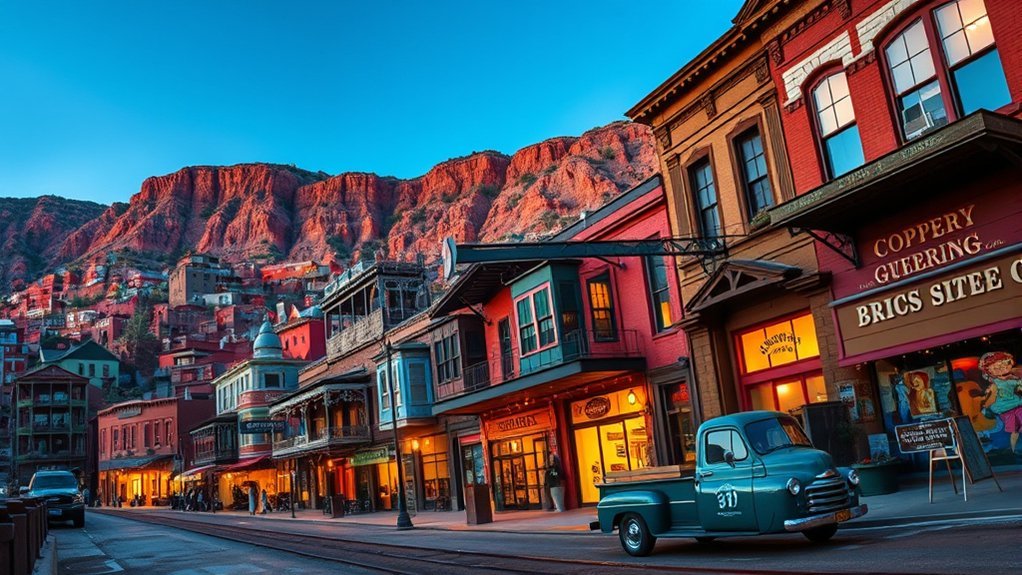
Though once a rugged copper boomtown, Bisbee now feels like a sun-warmed village of steep streets, colorful storefronts, and art spilling from galleries and side alleys. You wander narrow lanes where muraled walls and hand-lettered signs invite you to linger; every step reveals vintage architecture, quirky shops, and cafés that smell of fresh espresso and baking. The Copper Queen Mine gives a tactile contrast — you don a hard hat, board a low-slung tram, and feel the cool, echoing tunnels where miners worked.
A sun-warmed village of steep streets, murals, quirky shops, and the cool, echoing tunnels of Copper Queen Mine
- Explore downtown boutiques, galleries, and unexpected public art.
- Take the Copper Queen Mine tour to learn mining history and feel the subterranean scale.
- Pause at viewpoints for sweeping valley and mountain vistas, especially late afternoon.
You’ll find a town that’s both intimate and theatrical: history hums beneath creative reinvention, and the pace encourages curiosity. Bisbee rewards slow exploration and a readiness to be surprised around every bend.
Kitt Peak National Observatory: Stargazing and Hiking
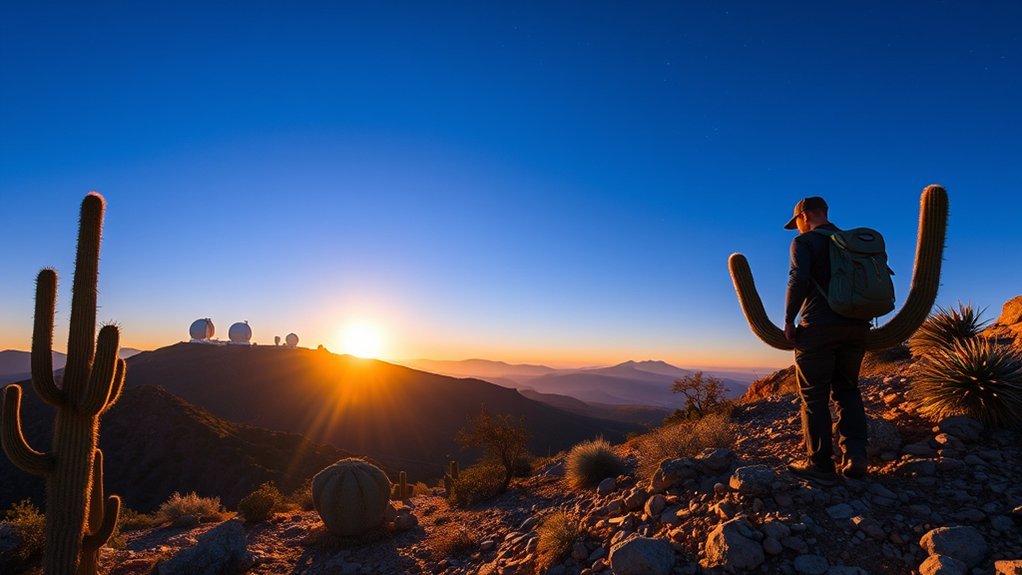
Perched on a rugged ridge southwest of Tucson, Kitt Peak National Observatory invites you to swap city glare for a dome-studded skyline and some of the darkest, clearest night skies in the Southwest. You drive winding roads through saguaros, arrive at a high, wind-sculpted plateau, and feel the altitude sharpen the air and your senses. By day you wander short trails that wind among antenna arrays and scrub oak, catching panoramic views of desert valleys and distant mountains. Interpretive signs explain the telescopes, and staff-led tours let you peek into the science behind the mirrors. As evening falls, the observatory’s programs guide you to observing sites where staff set up telescopes and point out planets, star clusters, and the Milky Way, bright and arching overhead. You’ll want a jacket—the nights are brisk—and a camera or notebook to record constellations and stories. Whether you linger for a sunset or stay for stargazing, Kitt Peak feels like discovery framed by silence and sky.
Patagonia and Sonoita: Wine Tasting and Birding
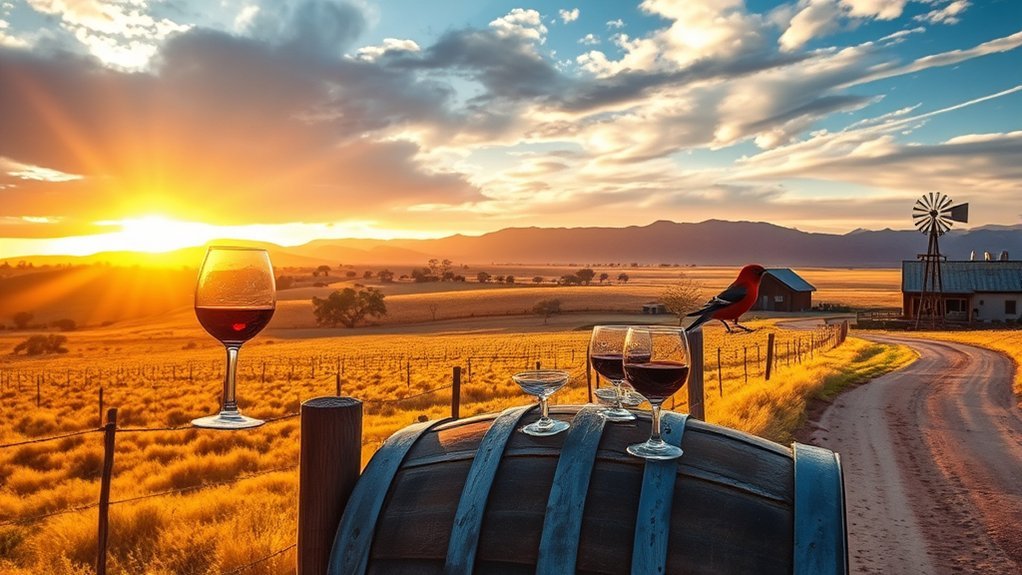
Head south of Tucson and you’ll find Patagonia and Sonoita, two small towns where rolling grasslands, cottonwoods, and oak-studded hills meet a surprising stretch of vineyards and lively bird habitat. You can sip local wines beneath wide skies, then scan willows and feeders for hummingbirds, sparrows, and raptors that ride the thermal currents. The pace is unhurried; you’ll swap tasting notes with vintners and trade binocular tips with locals.
- Wander tasting rooms that pair ripe Syrah and zesty Sauvignon with sunlit patios.
- Stroll short trails along creeks and ponds where elegant herons and colorful warblers show up at dawn.
- Visit small galleries and cafes in town for artisan goods and a final cup before heading back.
You’ll leave feeling refreshed by open views and unexpected biodiversity, glad you chose a day that blends delicate flavors with clear, bird-filled skies.
Oracle and Biosphere 2: Science Hub and Desert Trails
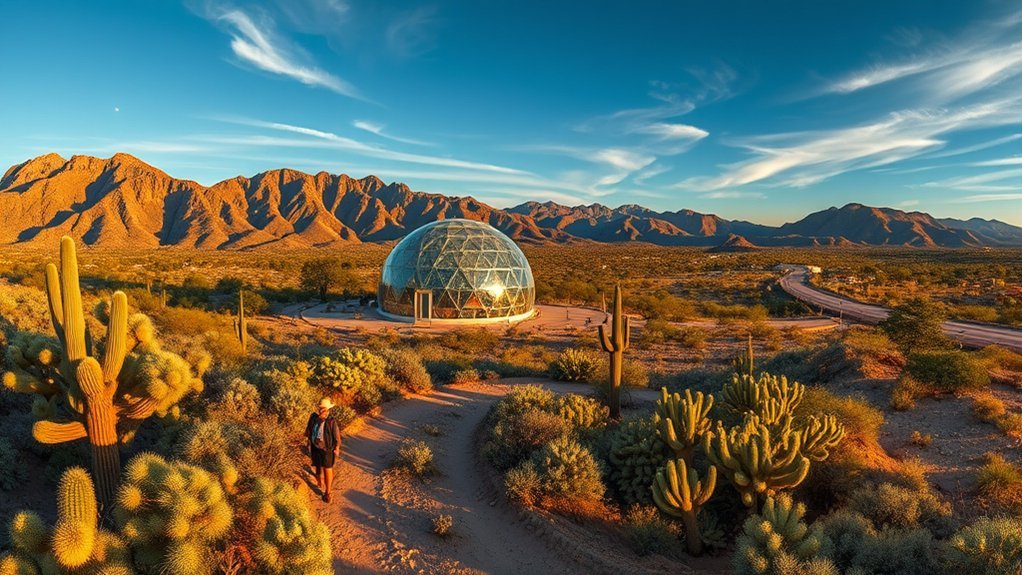
Head to Oracle to tour Biosphere 2 and witness its sealed ecosystems, glass-enclosed labs, and guided highlights that explain cutting-edge experiments. Then lace up for nearby desert trails that wind through saguaro-studded slopes and offer crisp views of the Catalina range. Along the way you’ll find interactive exhibits and outreach programs that make the science feel immediate and inviting.
Biosphere 2 Tour Highlights
If you’re curious about cutting‑edge environmental research and a quirky piece of scientific history, a visit to Biosphere 2 and the nearby Oracle science hub delivers both — up close. You’ll walk through glassed biomes, listen to guides who lived in the sealed experiment, and watch modern research instruments hum. The architecture frames experiments and landscapes like a living museum.
- Explore the rainforest chamber’s humidity and layered plants, feeling the difference immediately.
- See the marine lab’s tidal tanks and learn how researchers study ocean‑land interactions.
- Peer into the agricultural and desert biomes to understand closed‑system challenges and innovations.
You’ll leave with vivid images of controlled ecosystems and a clearer sense of human‑scale ecological inquiry.
Oracle Hiking Trails
Set among the scrubby slopes north of Biosphere 2, Oracle’s hiking trails invite you to trade lab coats for hiking boots and explore a high‑desert landscape where science and solitude meet. You’ll follow sunbaked paths that curl around saguaros, ocotillos and rocky outcrops, each turn revealing wide valley views and distant mountain silhouettes. The trails range from gentle loops to steeper ridgelines, so you can pick a stroll or a heart‑pumping climb. Keep an eye out for lizards basking on stones and for birds that ride the thermal currents. Benches and shady wash crossings offer natural pauses to listen, photograph or simply breathe in the dry, fragrant air. Trail markers are clear; maps at trailheads help you choose time and distance.
Science Outreach & Exhibits
Although the Biosphere 2 campus feels like a working laboratory, it’s also a welcoming science hub where you can join hands‑on programs, catch informal talks and walk desert trails that double as outdoor classrooms. You’ll find exhibits that make complex ecology feel immediate: glassed experiments, interactive displays, and researchers willing to explain what they’re tracking. Outside, trail signs point to native plantings and microhabitats, so you’ll notice connections between lab data and the scrubland around you. Expect a relaxed, curious vibe—families, students and solo visitors all ask questions. Take a guided tour or wander with a brochure; either way, you’ll leave with sharper eyes for desert life and renewed interest in how science shapes stewardship.
- Guided lab and campus tours
- Hands‑on workshops and talks
- Desert interpretive trails
San Xavier Del Bac and Mission Cultural Sites
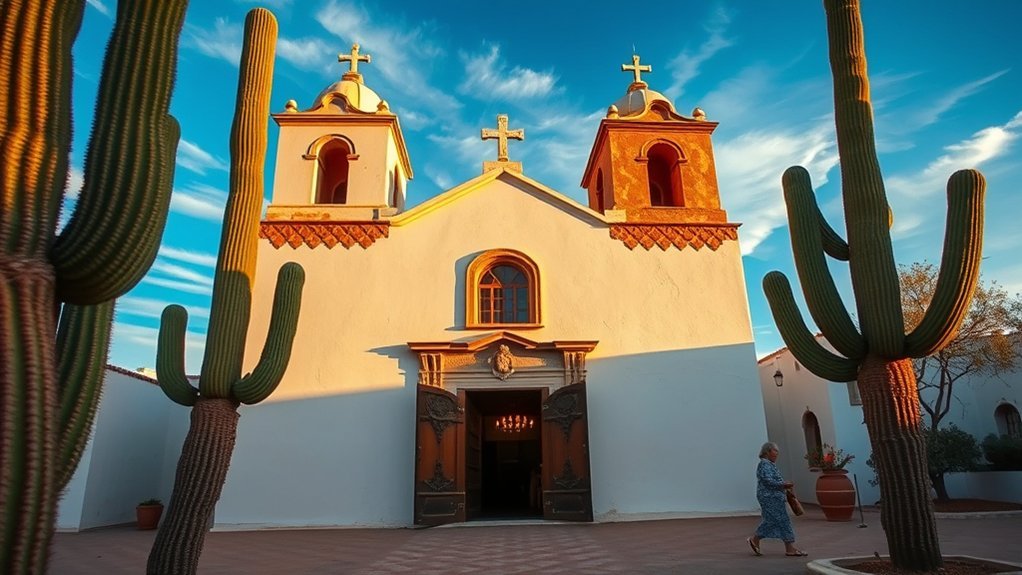
When you step onto the sandy courtyard of San Xavier del Bac, the whitewashed mission rises like a desert mirage—ornate domes and carved stonework glowing against the blue Arizona sky. You’ll notice the cool hush inside, frescoes and gilded altarpieces that thrum with centuries of devotion. Guided tours explain Spanish colonial architecture and Tohono O’odham traditions woven into the site; you’ll learn the mission’s layered history without feeling lectured. Outside, explore nearby cultural sites where artisans sell woven baskets, pottery, and silverwork—each piece carrying local stories. Photography captures light on stucco and the surrounding saguaros, but pause to watch community life: elders visiting, children running, ceremonies held on special days. You’ll leave with a clearer sense of place—its resilience, faith, and creativity—and a small, authentic memento if you wish. It’s an intimate, accessible day trip that connects you to Tucson’s deeper cultural roots.
Frequently Asked Questions
Are These Trips Wheelchair- or Stroller-Accessible?
Some are, some aren’t — you’ll find paved paths, accessible visitor centers, and shuttle options at a few sites, but rugged trails and uneven terrain limit access elsewhere. Check specific attraction accessibility details before you go.
What Are Pet Policies for Each Destination?
Pets policies vary: you’ll find many trails allow leashed dogs, some parks restrict pets to picnic areas, national monuments often ban them on interpretive paths, and guided tours usually disallow animals — check specific site rules beforehand.
Is Public Transportation Available to These Sites?
Mostly no — you’ll need a car for many sites, though some spots have limited bus or shuttle access and seasonal tour shuttles. Check local transit schedules and visitor centers; biking or rideshares fill gaps for flexible, scenic access.
Are There Restroom and Water Refill Facilities?
Yes — many sites have restrooms and water refill stations, but they’re intermittent. You’ll find reliable facilities at visitor centers and popular trailheads, while remote spots often lack services, so pack water and plan pit stops.
What Are Cellphone Reception and Charging Options?
Cell service’s spotty in remote spots, but you’ll get signals near towns and major roads. Pack a car charger, portable power bank, and solar charger if hiking; don’t rely solely on public outlets or inconsistent reception.
Conclusion
From saguaro-studded loops to cool pine drives, Tucson’s day trips mix easy adventure with vivid history and quiet beauty—so which one will you choose first? Each outing lets you step into sweeping desert panoramas, subterranean hushes, or star-filled skies, and you’ll find accessible trails, scenic drives, and cultural stops waiting within an hour or two. Pack water, a camera, and curiosity—you’ll leave with fresh stories, photos, and a new love for southern Arizona.

